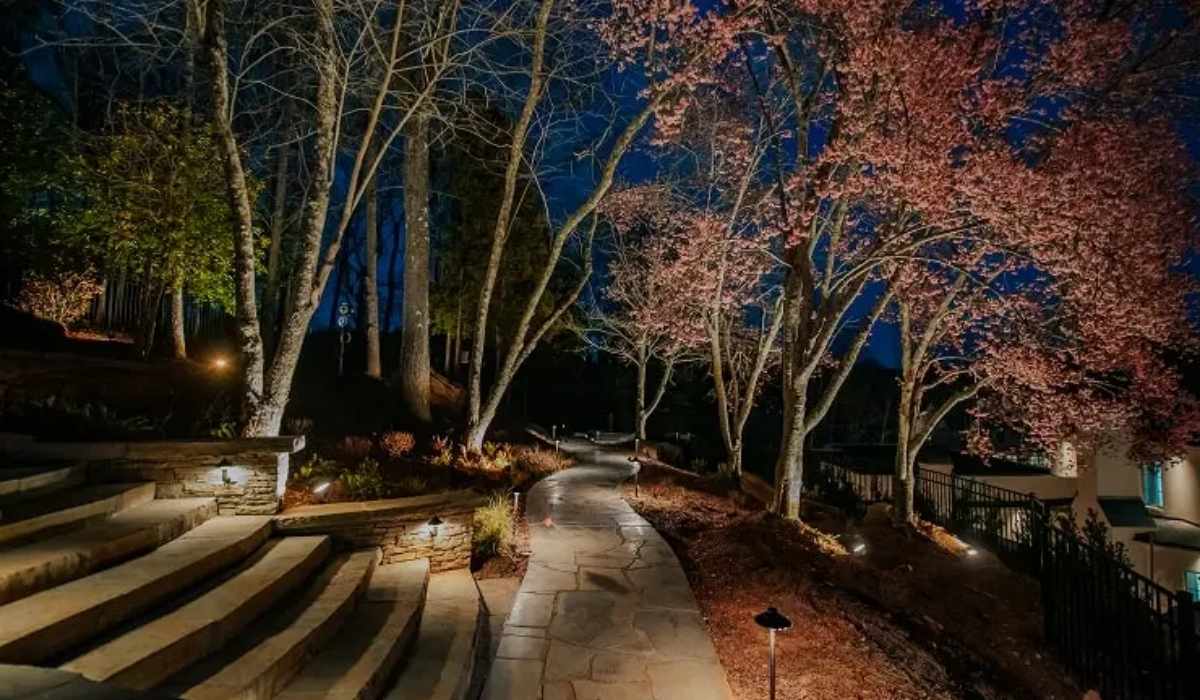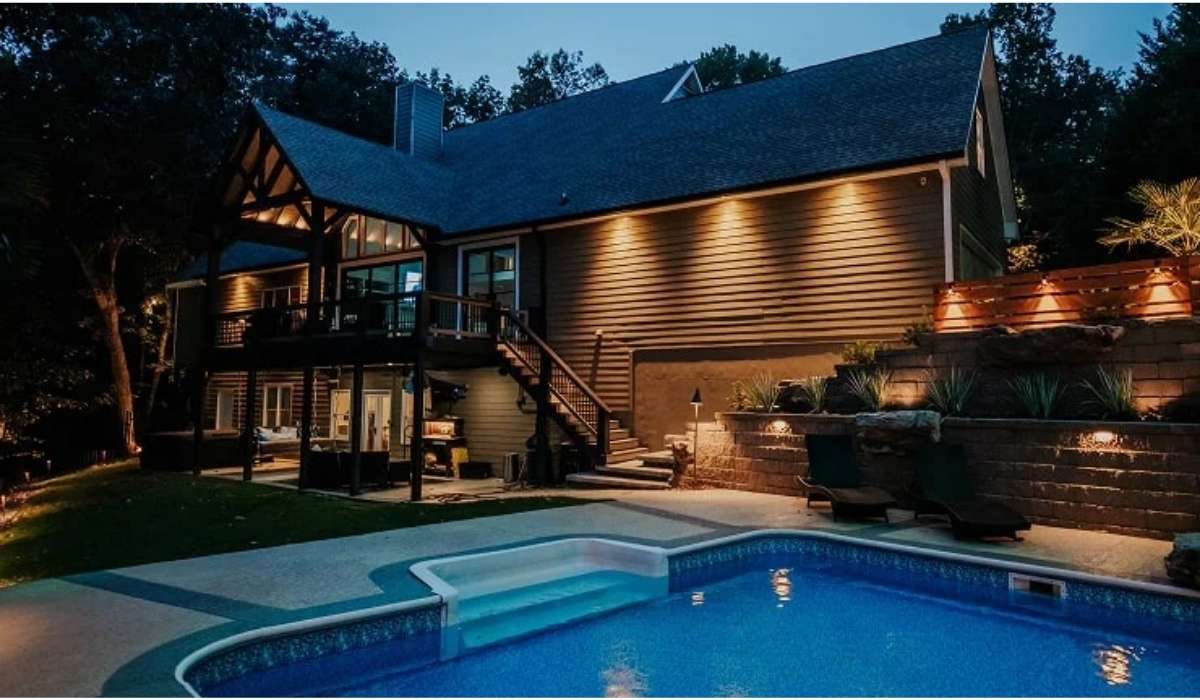When the sun sets, your outdoor space shouldn’t disappear into darkness.
In fact, with the right lighting, it can come to life in stunning and functional ways.
Whether it’s a backyard patio, garden walkway, or a commercial entryway, professionally installed lighting turns every inch of your landscape into an after-hours showcase.
At the heart of this transformation are landscape lighting installers—the trained experts who know how to blend aesthetics, technology, and utility into a flawless outdoor experience.
In this comprehensive guide, we’ll take you through the full journey of working with landscape lighting installers—from initial concept and design to final installation and maintenance.
Whether you’re a homeowner, business owner, or property manager, this article will help you understand why hiring professionals is worth every penny—and how it leads to safer, more attractive, and more valuable properties.
What Is Landscape Lighting?
Landscape lighting refers to the strategically planned illumination of outdoor spaces such as gardens, walkways, patios, decks, driveways, and building exteriors.
These lights serve multiple purposes: they increase visibility and safety, enhance architectural features, deter intruders, and elevate the atmosphere of a space.
Unlike basic outdoor lighting, professional systems are carefully designed to provide balance, contrast, and visual interest.
This is where landscape lighting installers come in—they take a vision and execute it precisely, using the best tools, products, and layout techniques available.
Why Landscape Lighting Matters
Most people invest in landscaping for daylight enjoyment—lush lawns, flowering gardens, stone walkways, and cozy patios.
But once the sun goes down, those features vanish without lighting.
Professionally installed landscape lighting not only brings them back into view but amplifies their beauty.
Here’s why quality lighting is a must-have:
- Curb Appeal: A home with glowing walkways and tastefully lit facades looks elegant and inviting.
- Security: Lighting deters intruders by eliminating dark areas around the property.
- Safety: Pathway and stair lighting prevent trips and falls.
- Extended Usability: Enjoy your yard, patio, or garden after dark.
- Property Value: Buyers are drawn to homes with beautiful, functional outdoor lighting.
None of these benefits happen by accident. They result from well-thought-out plans and expert installation—something only experienced landscape lighting installers can offer.
What Landscape Lighting Installers Do
Professional landscape lighting installers handle every part of your outdoor lighting project, ensuring long-lasting results. Their role can be divided into five essential stages:
1. Initial Consultation and Planning
Installers begin with a walkthrough of your property. They ask about your lifestyle needs (entertaining, security, highlighting features), and assess the landscape. Key considerations include:
- Power availability
- Topography
- Landscape features (trees, water features, walls)
- Focal points
- Desired lighting effects
Using this info, they create a tailored design plan that reflects your goals, style, and budget.
2. Lighting Design and Fixture Selection
Lighting is not just about visibility—it’s about mood and composition. Professionals use a combination of:
- Uplighting for trees and facades
- Downlighting for patios and gathering areas
- Path lighting for walkways and driveways
- Accent lighting for sculptures or water features
- Wall washing for texture and dimension
Installers also choose fixture materials that match your environment—copper, brass, or powder-coated aluminum are popular for their durability and aesthetics.
3. Wiring and Electrical Setup
Running wires and connecting transformers require technical skill and adherence to safety codes. Landscape lighting installers ensure:
- Safe low-voltage systems (usually 12V for residential)
- Waterproof connectors
- Hidden cable routes
- Compliance with local electrical codes
Proper wiring ensures your lighting works efficiently and lasts for years without frequent maintenance.
4. Installation and Adjustment
Once everything is laid out and connected, the lights are positioned and tested at night.
This allows installers to make live adjustments to angles, brightness, and spread.
The goal is a balanced, natural-looking layout—nothing too harsh or too dim.
5. Maintenance and Support
The best landscape lighting installers offer ongoing services to maintain your system. These include:
- Cleaning lenses and fixtures
- Replacing bulbs or LED modules
- Repositioning fixtures as trees grow
- Checking wire integrity
- Updating smart control systems
Types of Outdoor Lighting Offered by Installers
Each outdoor lighting element plays a specific role. The beauty of working with professionals is that they know how to combine these types to create harmony across your entire landscape:
Pathway Lighting: Keeps walkways lit and safe while adding visual charm.
Flood and Spotlights: Highlights large trees, architecture, or driveways for drama and safety.
Step and Deck Lights: Mounts into stairs and deck rails for safe movement and beautiful accent lighting.
Wall Washers: Casts even light across exterior walls or fences for texture enhancement.
Downlights and Moonlighting: Mounted in trees to cast a soft, natural light over the area—perfect for patios or dining spaces.
Underwater Lights: Used in fountains, ponds, or pools to create sparkle and movement at night.
DIY vs. Professional Landscape Lighting Installers
Some homeowners may be tempted to purchase plug-in kits from home improvement stores.
While these kits are convenient, they’re often unreliable, underpowered, and short-lived. Here’s why professional installation is worth the investment:
| Aspect | DIY | Professional Installer |
| Fixture Quality | Low to moderate | High-end, weatherproof materials |
| Lighting Design | Generic | Custom-tailored to your property |
| Electrical Safety | Risky | Fully code-compliant |
| Aesthetic Impact | Inconsistent | Professional and elegant |
| Lifespan | 1-2 years | 10+ years with proper maintenance |
| Support & Warranty | Limited or none | Long-term support and warranties |
In short: if you care about results that last and impress, hire trained landscape lighting installers.
Benefits of Hiring Certified Landscape Lighting Installers
Hiring certified landscape lighting installers offers multiple advantages, combining technical knowledge with design expertise to deliver exceptional results. Here’s what sets them apart:
- Experience with Complex Projects: Certified professionals have extensive experience working with challenging terrains such as sloped yards, densely planted gardens, and properties with water features or intricate hardscaping. They know how to install lighting safely and effectively in any setting.
- Advanced Lighting Controls: Professionals can incorporate modern lighting systems that include dusk-to-dawn timers, motion sensors, and smart technology. These systems can be controlled through mobile apps or integrated with home automation platforms for convenience and energy efficiency.
- Artistic Design Expertise: Lighting is not just functional—it’s a creative element of landscape design. Certified installers use techniques like uplighting, downlighting, and shadow play to highlight architectural and natural features while creating a desired mood or ambiance.
- Increased Property Value: A professionally lit exterior adds to a home’s curb appeal and perceived value. Homes with well-designed outdoor lighting tend to sell faster and at higher prices, offering a strong return on investment.
Working with certified installers ensures lasting quality, safety, and visual impact for your outdoor space.
Choosing the Right Landscape Lighting Installers
Selecting the right team can make or break your project. Here’s what to look for:
- Portfolio: Ask to see examples of completed work, preferably at night.
- Certifications: Look for companies with certified outdoor lighting professionals (COLP) or similar credentials.
- Warranties: Top installers stand behind their work and products.
- Client Reviews: Check Google, Yelp, and Houzz for real customer experiences.
- On-Site Demonstrations: Many offer temporary setups so you can see lighting concepts before committing.
Cost of Professional Landscape Lighting Installation
The cost of professional landscape lighting installation can vary widely depending on several key factors.
Understanding these variables can help you budget more accurately and make informed decisions about your project.
Factors that influence pricing include:
- Size of the Property: Larger areas require more fixtures, wiring, and labor, which naturally increases the overall cost.
- Number and Quality of Fixtures: Higher-end materials and advanced LED technology typically come at a premium but offer greater durability and aesthetics.
- Design Complexity: Custom lighting designs that involve multiple zones, specialty effects, or tailored layouts require more time and expertise to execute.
- Type of Control Systems: Manual switches are simple and affordable, while smart systems with app or voice control add convenience but can be more expensive to install and configure.
- Installation Challenges: Properties with sloped terrain, dense landscaping, hardscaping, or water features can present additional installation difficulties, which may affect the total cost.
For the most accurate pricing, it’s best to request a detailed quote from a certified landscape lighting installer.
A professional estimate should include all components, labor, and optional post-installation services such as maintenance or adjustments.
Eco-Friendly and Smart Lighting Options
Today’s landscape lighting doesn’t just look good—it’s efficient and intelligent:
LED Lighting
- Uses up to 80% less energy than halogen
- Longer life (25,000+ hours)
- Lower heat output, safer for plants and pets
Smart Controls
Control your lighting zones, brightness, and schedule from your phone. Integrate with Alexa, Google Assistant, or Apple HomeKit.
Case Study: How a Lighting Installer Transformed a Suburban Home
Take the example of a suburban homeowner who wanted to light her front yard, pathway, and backyard entertainment area.
She called a local landscape lighting installer, who offered a full design consultation.
The result:
- Path lights were added with dim warm LEDs to guide guests.
- Accent lights uplighting oak trees created a stunning entry view.
- Downlighting gave the patio a moonlit glow—perfect for evening BBQs.
- Motion sensor floodlights were added for security.
In just three days, her property went from average to exceptional.
Final Thoughts
Your home is a place of comfort, pride, and personal expression.
Don’t let it disappear into the night. With the help of landscape lighting installers, you can extend your enjoyment well past sundown, improve your safety and security, and dramatically enhance your property’s curb appeal.
Whether you want subtle accents or a full-blown lighting transformation, professionals bring the tools, knowledge, and creativity to make it happen.
FAQs
How long does installation usually take?
Installation time depends on the size and complexity of your lighting design. Smaller projects can be completed in just 1–2 days. Larger or more intricate systems may take 3–7 days, including testing and adjustments.
Can lights be installed in existing landscapes?
Yes, landscape lighting can be added to already landscaped yards. Installers use careful planning to work around plants, trees, and hardscaping without disturbing them. This allows for seamless integration of lighting into your current design.
Are landscape lights durable?
Yes, professionally installed landscape lights are built to last for many years. They are made from sturdy materials like brass or aluminum and are designed to handle outdoor conditions. Proper installation also ensures consistent performance over time.
Do I need a permit for landscape lighting?
In most residential areas, low-voltage outdoor lighting doesn’t require a permit. However, local building codes may vary depending on the electrical work involved. Your installer will be able to confirm if any permits are necessary.
What is the lifespan of LED landscape lights?
LED landscape lights typically last between 25,000 to 50,000 hours. This means they can function effectively for over 10 years with normal use. They’re also energy-efficient and require minimal maintenance.





